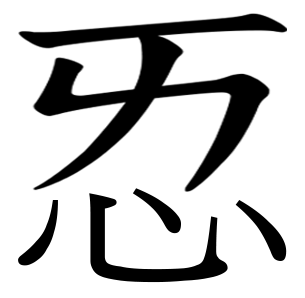This page houses some of my non-professional academic research and advocacy.
Chinese Character Simplification

More phonetic writing is generally easier to learn and use than less phonetic writing. Efforts to reform the orthography of various languages to be more phonetic and regular have a mixed history, but have sometimes been productive.
A few years ago, I developed a simplified suite of Chinese characters for writing Mandarin Chinese. These characters are much simpler and more phonetic than even the simplified Chinese characters used in Mainland China. However, distinct from proposals to write Mandarin 100% phonetically, they are flexible enough to be used for literary and ancient Chinese, and to represent personal names. This is achieved by preserving the semantic cues which disambiguate traditional Chinese characters.
Figures 1 and 2 show example characters. Figure 1 is a simplification for 愛 (“love”). A phonetic symbol (ㄞ) now gives the pronunciation, while the cue for emotion (心) is retained. This simplification is based on the ancient character 㤅, which 愛 is a corruption of. Figure 2 is a simplification for 勝 (“victory”). Phonetic symbols (ㄕㄥ) now give the pronunciation , while the cue for power (力) is retained. In both cases, the novel simplifications are simpler, clearer, and more etymologically justified than the simplifications in current use (爱 and 胜, respectively).

The example characters integrate Bopomofo phonetic symbols, though other options would also work. Further example characters can be found here (with apologies for my handwriting), and further documentation is available upon request.
This work is simply intended to stimulate discussion, and I would not advocate it as a complete or best-possible solution.
However, I would advocate the following: Chinese reading and writing is more difficult than it needs to be, and (further) Chinese character simplification is a more realistic approach to this issue than fully phonetic writing. Furthermore, “simplification” should mean promoting characters that are more phonetic and have a clearer structure, not simply adopting character variants with fewer strokes.
History and Preservation
I am interested in historic preservation, especially of the Pittsburgh region. Recently, I have advocated for the preservation of the historic B’nai Israel synagogue in Pittsburgh. In December 2018, I gave a presentation on the history of this synagogue to its incoming owners (slides).